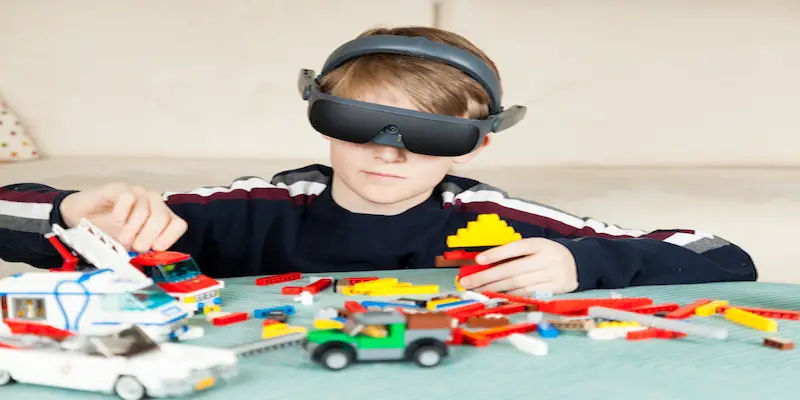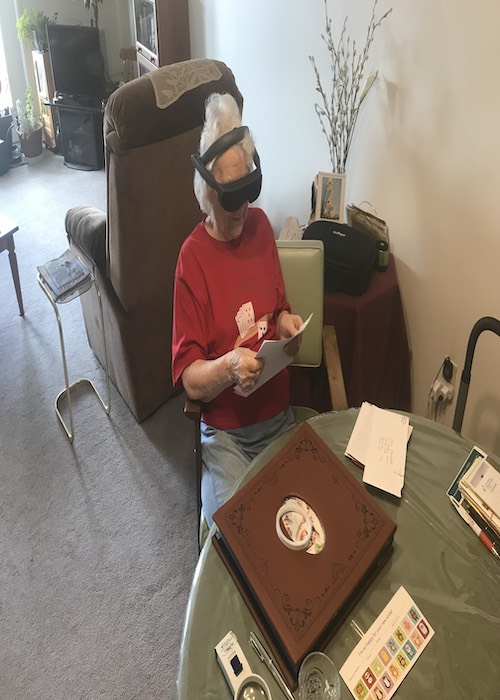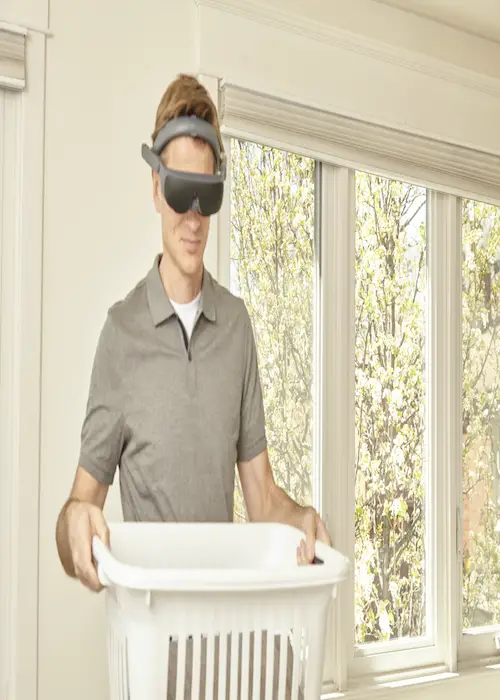
Introducing eSight: assistive technology for the visually impaired
eSight is an assistive technology company that specialise in electronic eyewear for the visually impaired. Here, eSight shares how its device benefited Canadian senior Velma Baudette, who was diagnosed with age-related macular degeneration (AMD), and how you can try out the eyewear yourself.
Velma’s eSight story
Velma first noticed her vision decrease when she looked at a phone book and could barely make out the words. She struggled to read her mail and reading fine print was almost impossible.
After seeking out specialists, Velma was diagnosed with age-related macular degeneration (AMD). Her vision impairment forced her to give up her favourite hobbies in addition to compromising her ability to see her family and live independently.
For a while, Velma tried to get by with a handheld magnifying glass, but the magnification was not powerful enough to help her see clearly during all her day-to-day activities.
Complicated tasks like driving or navigating a grocery store, which require both hands proved to be incredibly difficult.
Discovering eSight
Velma’s children researched possible treatments for their mother’s condition and came across eSight, an assistive technology company that specialises in retinal diseases like AMD.
Velma adjusted to the technology quickly after receiving her eSight device in December 2021. With this eSight device, she resumed her favourite hobbies of scrapbooking and sewing and was able to complete everyday tasks like cooking and cleaning independently.
“I can go see a movie now, which is very different from before. The decreased vision made me feel like I was just listening to the radio,” said Velma.
“eSight has made it possible for me to do a lot of things that I couldn’t have done otherwise.”
The origins of eSight
Our founder Conrad Lewis saw first-hand how vision impairment can rob someone of their independence. He watched as his two legally blind sisters — both living with Stargardt Disease — struggled to perform all the activities of daily living.
In an effort to help his sisters and many others live independently, the Canadian electrical engineer spent nearly 30 years perfecting a device that could help people with low vision and legal blindness.
This was the beginning of eSight Eyewear — a company dedicated to helping people with vision impairment explore new possibilities within current optical treatment until cures are found.
Currently, we are on the fourth version of our feature product, the eSight 4.
Used daily by thousands across the globe, this clinically validated device allows legally blind users to reach up to 20/20 visual acuity through its high-definition OLED lenses, patented bioptic tilt and centrally positioned front-facing camera.
The device incorporates the user’s natural peripheral vision for mobility retention. Wireless and hands-free, eSight 4 is the most versatile low-vision device.
“Mobility was one of our main priorities with the design of eSight 4,” states Roland Mattern, director of product marketing at eSight Eyewear.
“Other assistive wearables may allow an individual to read or work at their desk, but they are typically not portable or easy to use throughout the day. eSight 4 makes it possible.”
eSight wearability and usability
In addition to providing optimal mobility, the eSight 4 is designed to be lightweight for all day comfort. The device has an adjustable halo comfort band and can fit over prescription glasses, allowing users to wear it comfortably for hours at a time.
eSight is a class 1 medical device that is registered with the FDA, EUDAMED and inspected by Health Canada.
Although we were founded to combat the effects of Stargardt Disease, the assistive devices are compatible with over 20 eye conditions, including macular degeneration, diabetic retinopathy and others resulting in central vision loss.
While there are other tools for individuals with these conditions — such as magnifying glasses, video magnifiers and mobility devices — eSight is a comprehensive device that combines the technology and benefits of other devices.
This all-in-one solution utilises remaining photoreceptors to enhance central vision to provide the best possible experience.

eSight 4 availability
Currently, eSight 4 is available around the world. For North American residents, individuals with low vision can fill out a form on our website or call us at 1-855-837-4448 to learn more.
After a consultation to determine eligibility, we will send the device directly to the individual’s home for try-on.
When a new user purchases a new eSight device, they are paired with one of our certified coaches (all of whom are also eSight users) who assist in navigating the new device via video support. This coach will be at the user’s side throughout their time with eSight.
Residents in the UK can obtain an eSight device through VisionAid. Individuals with low vision can begin the consultation process by calling 0800 002 5555 or emailing enquiries@visionaid.co.uk.
After confirming eligibility, a completely free, no-obligation, in-home demonstration of eSight 4 can be organised.
For more details on international distributors, visit esighteyewear.com.
By eSight
Voice Activated Phones for the Visually Impaired
In addition to assistive technologies like eSight, voice-activated phones have become an indispensable tool for individuals with visual impairments. These devices offer a range of features designed to enhance accessibility and independence.
Key Features of Voice-Activated Phones
- Voice Assistants: Most smartphones come equipped with voice assistants such as Siri, Google Assistant, or Bixby. These assistants can perform a variety of tasks, from making calls and sending messages to setting reminders and accessing information, all through voice commands.
- Screen Readers: Built-in screen readers like VoiceOver (iOS) and TalkBack (Android) provide audio descriptions of the screen’s content, allowing users to navigate their phone without needing to see the screen[.
- Accessibility Settings: Modern smartphones include a range of accessibility settings that can be customized to meet individual needs. These settings can include text size adjustment, high contrast modes, and braille display compatibility.
Benefits for the Visually Impaired
Voice-activated phones offer several benefits for individuals with visual impairments:
- Enhanced Independence: By enabling users to perform tasks without relying on visual cues, voice-activated phones promote greater independence in daily life.
- Ease of Use: Voice commands simplify the interaction with the device, making it easier for visually impaired individuals to use their phones for various tasks.
- Integration with Other Assistive Technologies: Many voice-activated phones can integrate with other assistive devices and technologies, such as eSight, to provide a comprehensive solution for visual impairment.
How to Get Started
To get started with a voice-activated phone, individuals can:
- Consult with a Specialist: Discussing needs and preferences with a healthcare provider or an assistive technology specialist can help choose the right device and settings.
- Explore Device Options: Researching different smartphones and their accessibility features can help find the best fit.
- Practice Voice Commands: Familiarizing oneself with voice commands and practising their use can make navigating the phone more efficient.
By incorporating voice-activated phones into their daily lives, individuals with visual impairments can further enhance their independence and accessibility.
Top 5 Voice Activated Phones from Amazon UK
After reviewing the search results, I have compiled a list of the top 5 voice activated phones from Amazon UK. Here are the top picks, along with their features and benefits:
Table: Top 5 Voice Activated Phones from Amazon UK
| Phone Model | Features | Benefits |
|---|---|---|
| 1. Blind Shell Fully Talking Mobile Phone | Voice recognition, spoken input, dual SIM, 4G compatible, Bluetooth, WiFi | Easy to use, accessible for visually impaired, affordable |
| 2. Google Pixel 8 | Google Assistant, voice recognition, 5G compatible, high-quality camera, long battery life | Fast performance, excellent camera, timely software updates |
| 3. Samsung Galaxy A25 5G | Voice recognition, 5G compatible, large display, long battery life, affordable | Fast performance, large display, affordable price |
| 4. TCL Flip 2 | Voice recognition, flip design, long battery life, affordable, 4G compatible | Easy to use, affordable, long battery life |
| 5. Motorola Moto G | Voice recognition, 4G compatible, affordable, long battery life, durable design | Affordable, long battery life, durable design |
Top Pick: Blind Shell Fully Talking Mobile Phone
The Blind Shell Fully Talking Mobile Phone is our top pick due to its unique features that cater specifically to visually impaired individuals. The phone’s voice recognition and spoken input capabilities make it easy to use, and its affordability makes it an excellent value for money. Find out more here.
Honorable Mention: Google Pixel 8
The Google Pixel 8 is a close second due to its fast performance, excellent camera, and timely software updates. While it may not have the same level of accessibility features as the Blind Shell phone, it is still a great option for those looking for a high-end smartphone with voice recognition capabilities. Find out more here.
- Blind Paralympic sprinter Libby Clegg MBE in the spotlight
- Living with acute retinal necrosis: what it means for me
- Petition to make audio description available on ALL films, TV programmes and streaming services
- Buy a Ramble Tag guidance aid on the Disability Horizons Shop

